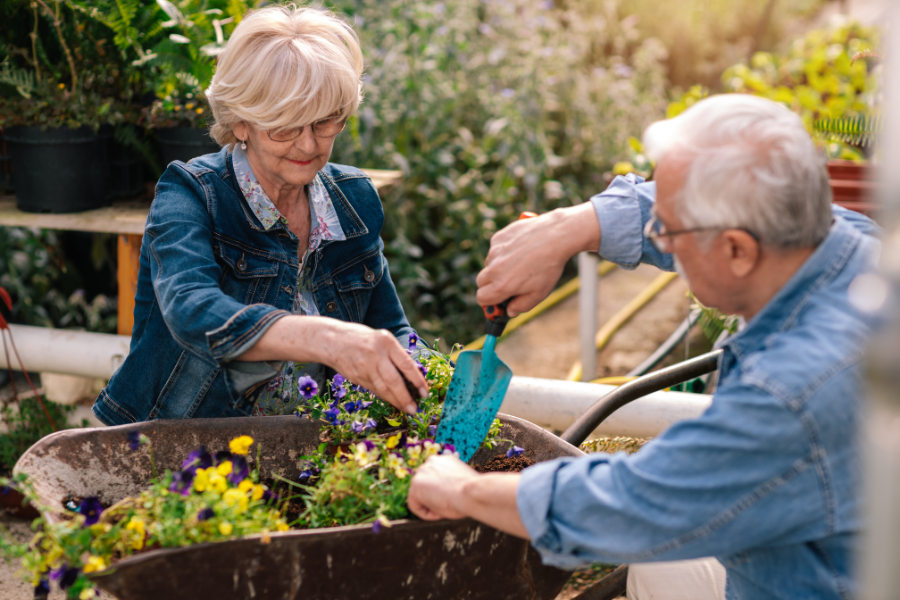As we journey into our sunset years, the significance of interpersonal relationships often comes to the forefront, especially when considering the challenges seniors find hard to face. The phrase “Social Connections in Later Life” is more than just a trendy term—it encapsulates a fundamental tenet of aging gracefully. Below, we delve deeper into the transformative benefits of these connections and offer guidance on establishing and nurturing them.
(1) Enhanced Mental Health: Not Just a Buzzword
Loneliness, especially during senior years, can quietly and profoundly impact one’s well-being, like an unseen adversary causing distress. Engaging in regular interactions and forming bonds during these years becomes crucial. When seniors actively foster and maintain social ties, that serves as a protective barrier. This barrier helps fend off the intense feelings of being isolated and guards against the serious emotional and psychological repercussions that can arise from it, such as depression and heightened anxiety.
Tip: To ensure regular social interaction, consider joining community groups, like a senior choir or a pottery class.
(2) Physical Health Gets a Boost, Too
Engaging in routine social activities has a hidden advantage: they often promote physical health without us even realizing it. When you prioritize your well-being by participating in simple activities like strolling in the park, joining dance classes, or participating in gardening clubs, you’re not just enjoying the company of others. These activities also play a significant role in enhancing heart health and ensuring that our muscles remain active and robust.
Tip: To maintain your heart healthy, you can attend bi-weekly salsa classes with other seniors.

Social connections in later life can help improve your health by keeping you active.
(3) Cognitive Sharpness: Keep that Brain Buzzing
Interacting with a diverse group of people and immersing oneself in wide-ranging discussions can be a powerful tool in maintaining mental sharpness. By continuously exposing the brain to new ideas and information, we can combat the gradual deterioration of cognitive functions often associated with aging.
Tip: Start a weekly trivia night at your local community center, become part of a book club, or attend educational lectures. Any of these activities will provide social interaction and mental stimulation, ensuring your brain remains active and flexible.

Join a book club to keep your mind sharp.
(4) The Pillar of Support in Turbulent Times
The support of friends and community groups becomes an indispensable anchor during life’s turbulent times. These relationships provide more than just companionship; they extend a compassionate ear, a deep understanding of what we’re going through, and sometimes even tangible help in navigating difficult situations. Such supportive networks reinforce the idea that we’re not alone, ensuring a safety net of care and assistance when we most need it.
Example: Suppose you are facing a health crisis. In that case, your chess club buddies can support you by organizing meals and hospital visits.
(5) Sharing Resources: The Information Network
Even in today’s digital era, where information is at our fingertips, word-of-mouth suggestions from close friends hold unparalleled value. There’s an innate trustworthiness to these personal endorsements. Whether you’re searching for a reliable plumber or curious about trying out a new pastime, the insights and recommendations shared within your social circle can serve as trusted guideposts, often making the difference between a frustrating experience and a rewarding one.
Tip: Initiate a monthly community bulletin or newsletter, both digitally and in print, to exchange resources and tips.
(6) Could Social Connections Add Years to Your Life?
Research indicates that having robust social connections in later life can extend one’s lifespan. The consistent happiness and upliftment derived from these positive social interactions, coupled with the decrease in stress they often bring, contribute to a lengthened life and qualitatively healthier. Thus, nurturing these connections becomes essential for emotional fulfillment and physical well-being.
Example: Studies have compared isolated individuals with those in tight-knit communities, often finding the latter group outlives the former.
(7) Purpose and Motivation: Fueling Daily Life
Engaging proactively in social endeavors isn’t just about staying occupied; it’s about finding a purpose that gives meaning to your life. Taking on leadership roles, such as heading a neighborhood watch or spearheading charity events, can breathe new life into one’s daily routine. These roles provide a sense of responsibility and infuse a renewed sense of passion and zest, making each day feel more significant and fulfilling.
Tip: Identify a cause you’re passionate about and rally fellow seniors to contribute their skills and time.
(8) Boosted Immunity: Not Just for the Young
Regular interactions in varied settings can expose seniors to common pathogens, which, paradoxically, might strengthen their immune response.
Tip: Attend diverse community events, ensuring you follow necessary health precautions, especially during flu season.
(9) Better Sleep Through Social Engagement
Stress and feelings of loneliness can significantly disrupt our ability to sleep soundly. These negative emotions and states of mind can often lead to restless nights. However, immersing oneself in rewarding social activities acts as a counterbalance. More precisely, by creating positive interactions and experiences, they help diminish these emotional stressors’ impact, leading to a more peaceful and rejuvenating sleep.
Tip: You can join a gardening club to improve your sleep patterns and health and find peace of mind.

Old friends gardening together.
(10) Confidence and Esteem: Shine Brighter
Being valued, respected, and active in social groups can elevate self-worth. It’s uplifting to know you’re a cherished part of a community.
Tip: Offer to share a skill or teach a class on a subject you’re proficient in, whether it’s baking, knitting, or storytelling.
Fostering Social Connections in Later Life: A Practical Guide
- Embrace Technology: Learn to use social media platforms or apps tailored for seniors. They can bridge the distance with family and help meet like-minded individuals.
- Volunteer: Offering your time and skills benefits others and introduces you to new people and environments.
- Community Centers: These hubs often have calendars packed with events, classes, and clubs catering to various interests.

Learn how to use social media to stay connected with friends and family.
In Conclusion: Cherish Every Connection
The intricate tapestry of social connections in later life can dramatically influence the quality of one’s golden years. The impacts are profound and multifaceted, from bolstering physical health to enriching the soul. We must prioritize these connections as we age, recognizing their power to transform, uplift, and illuminate our lives.
Written by: Betty T. Lewis
About the Author: Betty T. Lewis, a dedicated Heart Moving Manhattan team member, has a genuine passion for guiding individuals on their journey to age gracefully. Drawing from her experience in relocating people to ideal living spaces, Betty believes in the synergy of finding the right home and cultivating a healthful lifestyle to achieve holistic well-being in one’s golden years.








